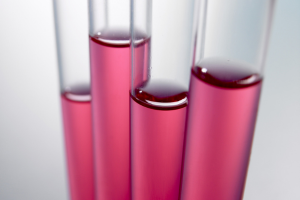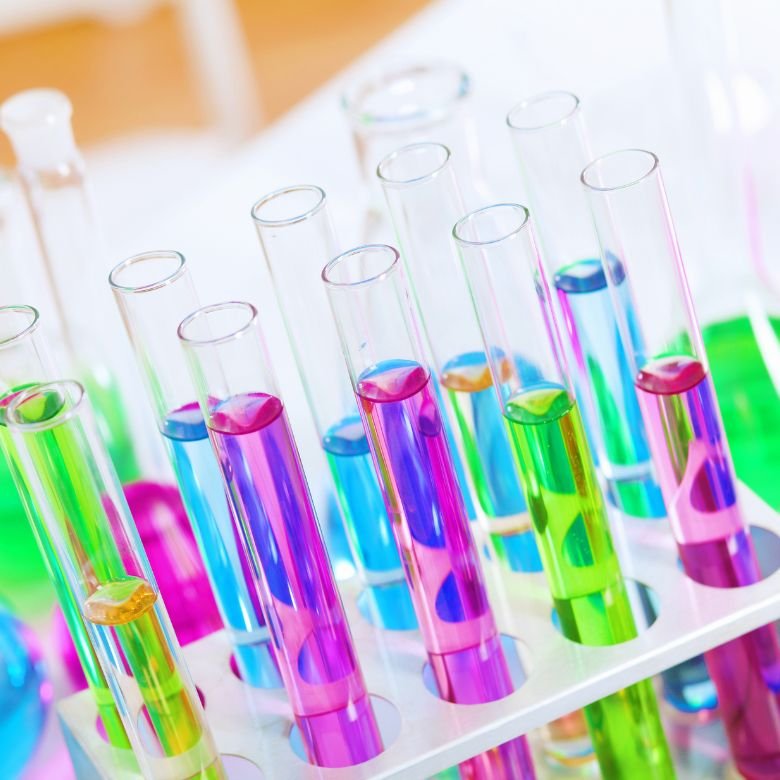Hydrides are compounds consisting of hydrogen atoms linked with other elements, having the general formula XmHn. They are composed of only two elements. Depending on the electronegativity of the other element present in the molecule, we distinguish saline, covalent and metallic hydrides.

Saline hydrides
Also called ionic hydrides. They are characterised by ionic links in which the hydrogen is present in the form of an H– anion. They are produced when elements with a very low electronegativity are able to give their electrons to the hydrogen atom. Such hydrides are formed as a result of linking between a metal from group 1 and group 2 of the periodic table, except beryllium and magnesium. They are solids having an ionic crystal lattice. These hydrides are formed as a result of hydrogen directly interacting with metals at an elevated temperature. Contacted with water, they react intensely and give off hydrogen, for example:
CaH2 + H2O = CaO + 2H2
Covalent hydrides
These are chemical compounds that contain hydrogen linked by a covalent bond. They are formed when highly electronegative elements are capable of sharing electrons and, consequently, creating covalent bonds with the hydrogen. Such molecules are formed by the elements from groups 14 to 18 of the periodic table as well as by boron (group 13) . Such hydrides are often highly volatile. They take the form of soft solids with flammable properties. A crystal lattice of covalent hydrides consists of molecules that are bonded with one another by van der Waals forces and sometimes also by hydrogen bonds. Their stability declines with the increase of the atomic mass of the element linked with hydrogen and with increasing metallic character of that element. Thus, the stability decreases in the order: HF, HCl, HBr, HI (where the atomic mass increases) and in the order: HI, H2Te, SbH3, SnH (where the metallic properties grow).
Metallic hydrides
They are combinations of hydrogen and d-block and f-block transition metals. They have characteristic shine and metallic properties. Unlike covalent hydrides, they are non-volatile. It may be difficult to express the composition of such hydrides as their formulas often include non-integer values, such as PdH0.6, TiH1.73, ZrH1.92. The hydrogen atoms present in metallic hydrides take interstitial positions in the metallic lattice, formed by the atoms of the metal element.
Compounds of hydrogen and halogens
Chemical molecules produced by combining halogens with hydrogen are called hydrogen halides, and their general formula is HX. Dissolved in water, they are called hydrohalic acids. In terms of industrial use, hydrogen fluoride and hydrogen chloride are the most important among hydrogen halides, but there are also other widely used substances, for example hydrogen bromide or hydrogen iodide. These hydrides are classified as covalent hydrides, because their character is most similar to that group. For hydrogen fluoride, which contain the most electronegative halogen, its ionic character does not exceed 45%. The ionic character declines with each subsequent compound to reach 5% for hydrogen iodide. The same declining trend can be observed for the change of dipole moments. The production of hydrogen fluoride and hydrogen chloride is based on the reaction of an appropriate salt with concentrated sulphuric acid. To prepare HF, we use fluorite, while HCl is produced from ammonium chloride (sal ammoniac). However, hydrogen chloride can also be obtained by direct synthesis from its elements, i.e. by direct combustion of hydrogen in chlorine. The use of concentrated sulphuric acid is impossible only in the case of iodine and bromine, as the resulting hydrides may quickly oxidise.

Compounds of hydrogen and chalcogens
These are mainly molecules of the general formula H2X, which include water, hydrogen sulphide, hydrogen selenide, hydrogen telluride and hydrogen polonide. In room temperature, only water is a liquid, while the rest of them are colourless gases. Two of the mentioned substances, hydrogen sulphide and hydrogen selenide, are characterised by the odour of rotten eggs. Sulphur and selenium hydrides show some toxicity, the former at higher concentrations. In the nature, only hydrogen sulphide can be present in free state, which can be found in sulphidic waters and in volcanic fumes. As water is widespread all over the world, it is very easy to obtain; however, for laboratory purposes water is purified by distillation, double distillation or by passing through a layer of organic ion exchangers. Other chalcogen hydrides are usually produced by treating metal containing compounds such as sulphides, selenides or tellurides with an acid. The structure of H2X hydrides is angular; the largest angle, equalling 104,5°, is present in the water molecule.
Compounds of hydrogen and pnictogens
Combined with hydrogen, every element classified as an pnictogen can form hydrides of the general formula XH3. In addition, phosphorus and nitrogen form X2H4 compounds. There is also one exceptional nitrogen hydride: HN3, referred to as hydrogen azide. The most popular XH3 hydrides include ammonia, phosphane, arsane, stibane and bismuthane. They are highly volatile substances that are present as colourless gases. They are often characterised by a distinct, unpleasant odour. All pnictogen hydrides, except ammonia, are formed by endothermic processes. The molecules of trihydrides have a pyramidal shape and the atom of the pnictogen has sp3 hybridisation.
Compounds of hydrogen and boron
Boron and hydrogen form a number of compounds with specific chemical and structural properties, called boranes. Most of them can be represented by the general formula BnHn+4 or BnHn+6; there is no simple borate of the formula BH3.
Compounds of hydrogen and alkaline earth metals
All alkaline earth metals combined with hydrogen form hydrides of the general formula XH2. The basic example of that group of compounds is beryllium hydride BeH2, which is produced in an ether solution with the use of BeCl2 and LiH as reactants. Beryllium hydride is colourless and hardly volatile. At 570 K, it decomposes into its elements. It reacts very easily with water. In its lattice, there are polymeric chains where the beryllium atom is linked by three-centre covalent bonds Be-H-Be. Another example of hydrides from that group is magnesium hydride, which is obtained by direct synthesis from its elements at an increased hydrogen pressure. It easily decomposes into its elements when heated. Other examples, that is, calcium, strontium and barium hydrides belong to the saline hydrides. In terms of industrial use, the most important one is CaH2, which is obtained by direct synthesis from its elements at an elevated temperature of around 670 K.
Alkaline metal hydrides
These are MH-type compounds that are produced by direct reactions between hydrogen and metals at elevated temperatures. As typical saline hydrides, they have ionic structure with the characteristic H– anion. At room temperature, alkaline metal hydrides are colourless solids that form lattices similar to sodium chloride. The highest stability, up to 720 K, is shown by lithium hydride.
